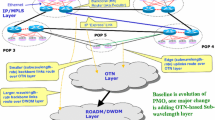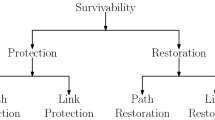Abstract
The main traffic to be carried by a backbone network in the future (or even now) will be (is) IP traffic, which is unidirectional and asymmetric in nature. Today, most backbone networks are still designed for bidirectional, symmetrical services like SDH/SONET. In the future, the transmission links in the optical layer will probably still be symmetric (same amount of capacity installed in both directions of the optical link), and operators will probably continue to lease bidirectional capacity to their customers. However, the traffic that will be conveyed over those bidirectional transmission links will be mainly unidirectional and asymmetric. This paper studies the influence of the asymmetric nature of IP traffic on the underlying optical layer. In case the optical layer contains bidirectional symmetric capacity (as is almost always the case nowadays), it shows how cost(in)efficient this optical capacity is used for IP traffic patterns with varying asymmetry. The comparison is also made with a unidirectional optical layer, in which the capacity (line-systems) installed in the network is asymmetric (more capacity can be present in one direction of an optical link than in the other direction), or in which the capacity that is leased by operators is asymmetric (e.g., an ISP can choose to lease two wavelengths from city A to city B and five wavelengths in the other direction, from city B to city A).
Similar content being viewed by others
References
L. G. Roberts, C. Crump, U.S. Internet IP Traffic Growth, http://www.caspiannetworks.com/pressroom/press/08.15.01.shtml (August 2001).
The European Information Technology Observatory, http://www.eito.com
J. P. Morgan Securities Inc. Equity Research, Backbone! How changes in technology and the rise of IP threaten to disrupt the long–haul telecom services industry, http://www.mckinsey.de/downloads/knowmatters/telecommunications/backbone.pdf (September 2000).
EISY–WAY, Evolution of information and communication and its impact on research activities, issue 2 (August 1999).
http://www.cisco.com/univercd/cc/td/doc/product/mels/dwdm/dwdm_fns.htm
M. Listanti et al., Architectural and technological issues for future optical Internet networks, IEEE Communications Magazine, vol. 38,no. 9, (September 2000), pp. 82–92.
T. W. Chung et al., Architectural and engineering options for building an optical Internet, http://www.canet2.net (September 1998).
M. A. Ali, A. Shami, C. Assi, Y. Ye, R. Kurtz, Architectural options for the next–generation networking paradigm: is optical Internet the answer?, Photonic Network Communications, special issue on IP Over WDM and Optical Packet Switching, vol. 3,no. 1/2, (January/June 2001), pp. 7–22.
D. Colle et al., MPLS recovery techniques for IP–over–WDM Networks, Photonic Network Communications, special issue on IP Over WDM and Optical Packet Switching, vol. 3,no. 1/2, (January/June 2001), pp. 23–40.
D. Colle et al., Data–centric optical networks and their survivability, IEEE Journal on Selected Areas in Communications, special issue on WDM–based network architectures, vol. 20,no. 1, (January 2002), pp. 6–20.
K. Thompson, G. J. Miller and R. Wilder, Wide–area Internet traffic patterns and characteristics, IEEE Network, vol. 11,no. 6, (November/December 1997), pp. 10–23.
Minho Kang, Optical Network Innovation toward Next Generation Internet, http://www.netmanias.com/contents/workshop/workshop/netfocus/l.pdf (May 2001).
http://www.napster.com
http://www.gnutellanews.com/information/what_is_gnutella.shtml
B. St. Arnaud, Current optical network designs may be flawed, Optical Networks Magazine, special issue on Protocols and Technologies for IP Internetworking, vol. 2,no. 2, (March/April 2001), pp. 21–28.
D. Colle et al., Envisaging next–generation data–centric optical networks, Proc. Workshop on design of reliable communication networks (DRCN) 2001, (Budapest, Hungary, September 2001), pp. 137–144.
D. A. Schupke, Link and path asymmetry issues in IP over WDM transport network, Proc. Workshop on Optical Network Design and Modeling (ONDM) 2001, (Vienna, Austria, February 2001), pp. 287–296.
http://www.ietf.org/html.charters/udlr–charter.html
http://www.udcast.com
UniDirectional Link Routing Working Group of the IETF, http://www.ietf.org/html.charters/udlr–charter.html.
Architectures for Optical Data Networks, http://www.rbni.com/white2.html.
S. De Maesschalck, D. Colle, M. Pickavet, P. Demeester, Asymmetric IP traffic and its consequences for the optical layer, Proc. 27th european conference on optical Communication (ECOC) 2001, (Amsterdam, The Netherlands, October 2001), vol. 1, Mo.L.2.7, pp. 48–49.
R. Ahuja, T. Magnanti, J. Orlin, Network Flows: Theory, Algorithms and Applications, Prentice Hall, 1993.
M. Gryseels et al., A multilayer planning approach for hybrid SDH–based ATM networks, Proc. of 6th international conference on telecommunication systems (ICTS) 1998, (Nashville, USA, 1998), pp. 461–474.
M. Gryseels, Planning of multi–technology telecommunication networks, Ph.D. thesis, Ghent University, Belgium, 2001.
Author information
Authors and Affiliations
Rights and permissions
About this article
Cite this article
Maesschalck, S.D., Pickavet, M., Colle, D. et al. Influence of the IP Traffic Asymmetry on the Cost of the Optical Network Layer. Photonic Network Communications 4, 133–150 (2002). https://doi.org/10.1023/A:1015387211573
Issue Date:
DOI: https://doi.org/10.1023/A:1015387211573




